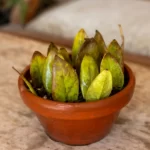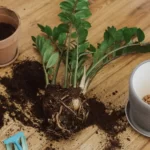An Overview of ZZ Plant Propagation
The ZZ plant (Zamioculcas zamiifolia) is a popular and easy-to-grow houseplant prized for its shiny, deep green leaves and its ability to thrive in low-light environments. ZZ plants are extremely easy to propagate through a variety of methods, allowing you to multiply your collection easily.
Propagating ZZ plants is a great way to get more plants for free. It also allows you to produce genetically identical clones of a particularly attractive ZZ plant specimen. This article provides a complete overview of the different techniques for propagating ZZ plants at home.
Propagating ZZ Plants Through Division

When to Divide ZZ Plants
Division is one of the easiest methods of propagating ZZ plants. It simply involves separating the rhizomes and tubers of a mature, established ZZ plant to make new plants.
The best time to divide a ZZ plant is during the spring and summer when the plant is actively growing. Avoid dividing in the fall or winter when the plant is dormant.
Signs that a ZZ plant is ready for division include:
- The plant has become overcrowded in its pot.
- Growth has slowed down.
- The plant is top heavy and tipping over.
- The plant has reached the maximum size for its pot.
Dividing overgrown ZZ plants will stimulate new growth and invigorate the plants.
How to Divide a ZZ Plant
Dividing a ZZ plant is a straightforward process:
- Remove the plant from its pot and gently loosen the soil and roots.
- Identify the rhizomes – these are the enlarged, bulbous structures that generate new shoots and roots.
- Use a sterile, sharp knife or pruning shears to cut the rhizomes apart, ensuring each division has 3-5 leaves and some healthy roots attached.
- Allow the cut surfaces to dry out for a day or two to callous over.
- Repot the divided rhizomes individually into pots with well-draining potting mix, about 2 inches wider than the root ball.
- Water well and place in bright, indirect light. New growth should emerge in a few weeks.
Propagating ZZ Plants from Rhizomes and Bulbs

When to Propagate from Rhizomes and Bulbs
Like division, propagating ZZ plants from rhizomes and bulbs is best done when the plant is actively growing in spring and summer.
When repotting or dividing ZZ plants, you may find small rhizome sections or individual tubers that broke off accidentally. These can be used for propagation.
You can also carefully detach small rhizomes and tubers from the mother plant for propagation purposes.
How to Propagate ZZ Plants from Rhizomes and Bulbs
Propagating from rhizomes and bulbs is easy:
- Allow the cut surfaces of the rhizome or bulb to dry out for 1-2 days.
- Place in a shallow container of well-draining potting mix so the top 1/3 of the rhizome is above the soil surface.
- Water sparingly, keeping the soil barely moist but not soggy.
- Place in bright, indirect light. New leaf growth will emerge in 2-3 months as the rhizome establishes roots.
- Once there is good root growth, repot into a slightly larger pot.
Propagating ZZ Plants from Stem Cuttings

When to Take Stem Cuttings
Taking stem cuttings is the best way to propagate certain attractive, variegated ZZ plants that you want to copy exactly.
For the highest success rate, take 4-6 inch stem tip cuttings in spring or summer when the plant is actively growing. Avoid fall and winter.
How to Propagate ZZ Plants from Stem Cuttings
Follow these steps for propagating ZZ plants from stem cuttings:
- Use a sterile, sharp knife or pruners to remove a stem tip cutting that is 4-6 inches long. Ensure it has at least 3 leaves.
- Strip the bottom 2 sets of leaves and trim the stem at an angle.
- Place the cutting in a glass of water or moist potting mix. Keep it in bright, indirect light.
- Change the water frequently and replenish moisture in potting mix as needed.
- New roots and leaves will generate in 4-8 weeks. Transfer to a pot once well rooted.
Propagating ZZ Plants from Leaves

When to Propagate from Leaves
ZZ plants can be propagated from a single leaf. The best time to collect leaves for propagation is during the active growing season in spring and summer.
You can remove 1-3 healthy leaves from the mother plant without harming it. Look for leaves that are intact and have no blemishes or damage.
How to Propagate ZZ Plants from Leaves
There are a few different ways to propagate ZZ plants from leaves:
- In water: Remove the leaf from the base with a clean cut. Place the cut end in water in a bright location. Roots and shoots will eventually emerge from the end in the water.
- In soil: Remove the leaf and stick the end shallowly in moist potting mix so it stands upright. New growth will form eventually.
- Cut leaf in sections: Cut the leaf into multiple 2-3 inch sections, leaving them joined at the base. Place in water or soil with the base submerged and the leaf sections sticking up. This increases the number of plants you can get from one leaf.
Be extremely patient, as growing ZZ plants from leaves can take 3-9 months and success rates vary. Once new shoots appear, care for the new plantlets normally.
Caring for Propagated ZZ Plants

Potting and Repotting
ZZ plants prefer being slightly root bound but dislike sitting in soggy soil. Use pots with drainage holes and well-draining potting mixes. Repot only when absolutely necessary, using a pot just 2 inches wider than the root ball.
Watering
Allow the soil to dry out between waterings but don’t let the plant wilt severely. Water less in winter when growth slows. The rhizomes are prone to rot if overwatered.
Light
ZZ plants grow well in moderate to bright indirect light. Low light will result in sparse, leggy growth. Some direct sun is tolerated, but avoid harsh afternoon sun.
Propagation Troubleshooting
Issues like leaf drop, failure to root, or rhizome rot are often caused by overwatering, low light, or using non-draining pots. Adjust conditions and be patient for the best results.
Tips for Successful ZZ Plant Propagation
- Propagate in spring or summer for the highest success rate.
- Use sterile, sharp tools to avoid disease transmission.
- Allow cut surfaces to dry out before planting to prevent rot.
- Water sparingly and use well-draining soil mixes.
- Be extremely patient – propagation can take months.
- Propagate multiple leaves, stems, rhizomes, and tubers for the best shot at getting new plants.
Frequently Asked Questions about ZZ Plant Propagation
How long does it take ZZ plants to propagate?

Most ZZ plant propagation techniques take 2-9 months to generate new plants. Stem and rhizome division are the fastest at 2-3 months. Leaf and stem cuttings are slowest at 3-9 months.
Can ZZ plants be propagated in water?

Yes, ZZ plants can be propagated in water alone. Leaves and stem cuttings can be rooted by placing the cut end in water. Change the water frequently to prevent rotting.
Do ZZ plant leaves propagate?

ZZ plant leaves can be propagated, but it is a very slow process that can take up to 9 months and has a low success rate. The leaf needs to generate new shoots and roots before becoming a new independent plant.
How do you propagate ZZ plants from leaves?

To propagate ZZ plants from leaves, remove a healthy leaf and place the cut end in water or moist potting mix so it’s upright. Roots and shoots will eventually emerge from the base of the leaf, forming a new plantlet. Rooting hormones can speed up the process.
Why is my propagated ZZ plant not growing?

Lack of growth in propagated ZZ plants is usually caused by insufficient light, overwatering, or impatience. Ensure the plant gets plenty of indirect sun, allow the soil to dry out between waterings, and wait at least 3-4 months before new growth emerges.

3 thoughts on “ZZ Plant Propagation is Super Easy – Here’s How to Do It”